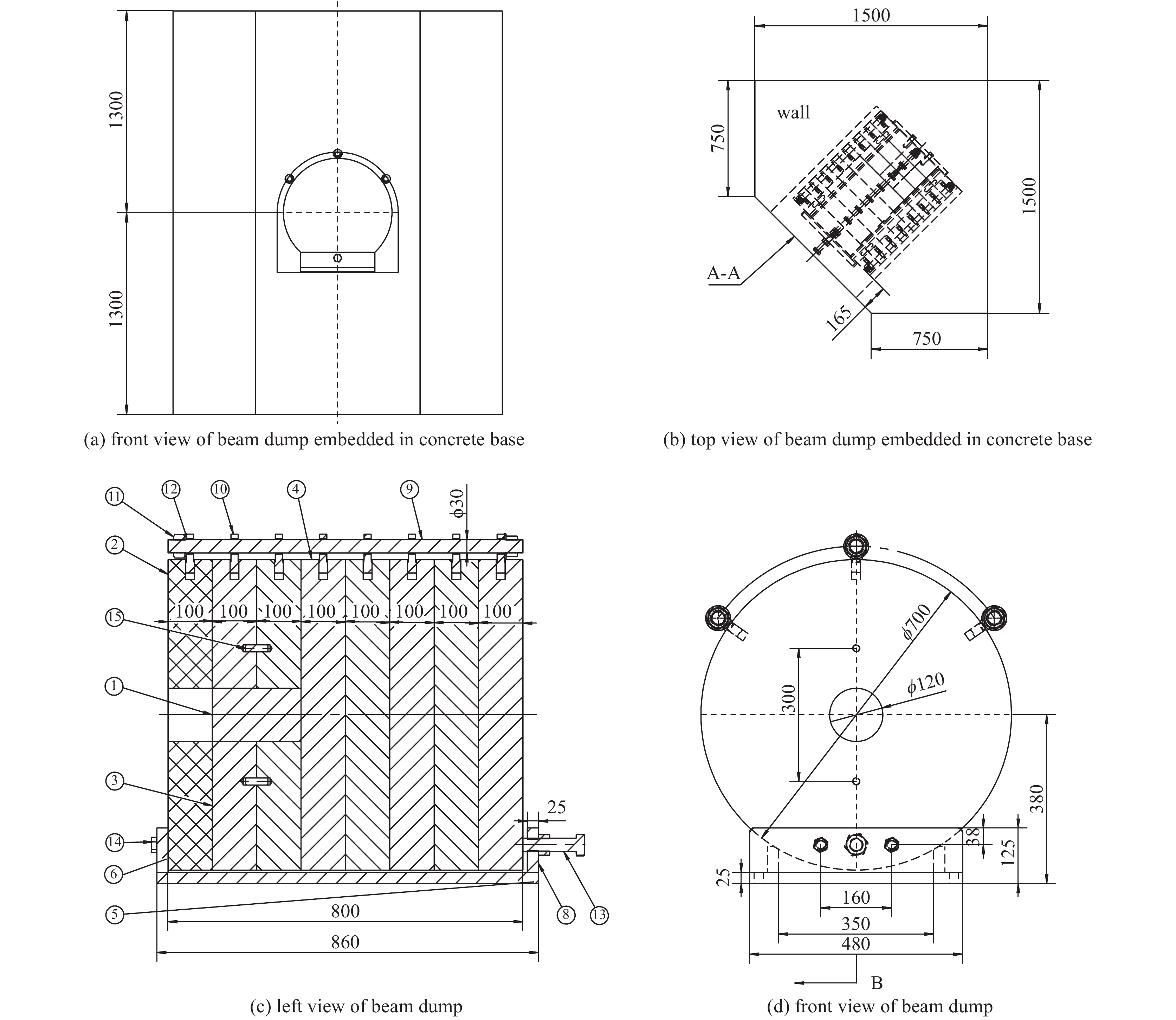Radiation protection analysis of 95 MeV RF electron linac
-
摘要: 应相关建设安评、环评、稳评以及职业健康评估的要求,电子加速器设计过程中即应对其辐射情况进行分析。针对电子能量为40~95 MeV可调的光阴极微波电子枪直线加速器,对其辐射源项进行分析,并讨论了可能的辐射防护措施的效果。采用蒙特卡罗软件FLUKA对电子束流和加速器进行建模,通过模拟计算发现,加速器产生的等效剂量分布主要位于废束桶中,废束桶以外辐射剂量迅速下降,在电子加速器实验大厅四周设置混凝土墙体的情况下辐射等效剂量率将随墙体厚度迅速下降。若混凝土墙体厚度设置为1 m,则墙体外工作人员所在区域辐射等效剂量率不高于1 μSv/h量级,能够有效屏蔽加速器产生的电离辐射,给工作人员提供有效防护。研究方法及结果对同能区同类型加速器建设中的辐射分析及辐射防护评估具有一定的参考价值。Abstract: According to the requirements of relevant construction safety assessment, environmental assessment, stability assessment and occupational health assessment, the radiation situation of electron accelerator should be analyzed in the design process. The radiation source of photocathode RF electron gun linac with adjustable electron energy from 40 MeV to 95 MeV was analyzed, and the effect of possible radiation protection was discussed. Monte Carlo software FLUKA was used to model the electron beam and accelerator. Through simulation calculation, it is found that the dose equivalent distribution generated by the accelerator is mainly located in the beam dump, and the radiation dose outside the beam dump decreases rapidly. When the concrete shielding wall is set around the electron accelerator experimental hall, the radiation dose equivalent will decrease rapidly with the wall thickness. If the thickness of the concrete shielding wall was set to 1 m, the radiation dose equivalent in the area where the staff outside the shielding wall were located should not be higher than 1 μSv/h. So, the wall can effectively shield the ionizing radiation generated by the accelerator and provide effective protection for the staff.
-
表 1 各重要点位束流参数表
Table 1. Parameters of beam at important positions
No. important
positionremnant
beam/%normalization
parameterpath
length/cmpath length after interaction
point/cmbeam
energy/MeVγ ① origin point 100.000 0.00038 0.00 — 5 9.785 ② YAG1 99.962 0.00064 67.00 — 5 9.785 ③ start of acceleration1 99.898 0.00170 180.00 — 5 9.785 ④ end of acceleration1 99.727 0.00057 480.00 — 50 97.847 ⑤ YAG2 99.670 0.00019 581.00 — 50 97.847 ⑥ start of acceleration 2 99.651 0.00170 614.00 — 50 97.847 ⑦ end of acceleration 2 99.481 0.00030 914.00 — 95 185.91 ⑧ YAG3 99.450 0.00040 967.00 — 95 185.91 ⑨ YAG4 99.411 0.00147 1037.00 — 95 185.91 ⑩ interaction point 99.263 0.00139 1296.00 0.00 95 185.91 ⑪ YAG5 99.124 0.00015 1541.00 245.00 95 185.91 ⑫ start of bending magnetic field 99.109 0.00043 1568.10 272.10 95 185.91 ⑬ YAG6 99.066 0.00055 1644.10 348.10 95 185.91 ⑭ front end of beam dump 99.011 0.99011 1740.75 444.75 95 185.91 No. important
positionnormalized divergence/
(mm·mrad−1)geometric divergence/
(mm·mrad−1)beam size/
mm(rms)beam size/cm
(FWHM)divergence angle/
mraddivergence angle/mrad
(FWHM)① origin point 0.20000 0.02044 0.25000 0.05888 0.08176 0.19254 ② YAG1 0.21551 0.02203 0.23785 0.05601 0.09260 0.21807 ③ start of acceleration1 0.24167 0.02470 0.21736 0.05119 0.11363 0.26759 ④ end of acceleration1 0.31111 0.00318 0.16296 0.03838 0.01951 0.04595 ⑤ YAG2 0.33449 0.00342 0.14465 0.03406 0.02363 0.05566 ⑥ start of acceleration 2 0.34213 0.00350 0.13867 0.03266 0.02522 0.05938 ⑦ end of acceleration 2 0.41157 0.00221 0.08427 0.01984 0.02627 0.06187 ⑧ YAG3 0.42384 0.00228 0.07466 0.01758 0.03054 0.07192 ⑨ YAG4 0.44005 0.00237 0.06196 0.01459 0.03820 0.08996 ⑩ interaction point 0.50000 0.00269 0.01500 0.00353 0.17930 0.42225 ⑪ YAG5 0.50000 0.00269 0.43929 0.10345 0.17930 0.42225 ⑫ start of bending magnetic field 0.50000 0.00269 0.48788 0.11489 0.17930 0.42225 ⑬ YAG6 0.50000 0.00269 0.62415 0.14699 0.17930 0.42225 ⑭ front end of beam dump 0.50000 0.00269 0.79744 0.18780 0.17930 0.42225 -
[1] 赵振堂, 高杰. 高能粒子对撞机加速器物理与设计[M]. 上海: 上海交通大学出版社, 2020Zhao Zhentang, Gao Jie. Physics and design for accelerators of high energy particle colliders[M]. Shanghai: Shanghai Jiao Tong University Press, 2020 [2] 李成龙, 汤振兴, 裴元吉. 低发射度L波段光阴极微波电子枪物理设计[J]. 核技术, 2016, 39:090203. (Li Chenglong, Tang Zhenxing, Pei Yuanji. Physical design of low-emittance L-band photocathode microwave electron gun[J]. Nuclear Techniques, 2016, 39: 090203 doi: 10.11889/j.0253-3219.2016.hjs.39.090203 [3] 陈佳洱. 加速器物理基础[M]. 北京: 北京大学出版社, 2012. (Chen Jia’er. Physics basics of accelerator[M]. Beijing: Peking University Press, 2012)) [4] 方锦清, 陈关荣. 强流加速器中的束晕-混沌现象的定性分析[J]. 中国原子能科学研究院年报, 2000:69-70. (Fang Jinqing, Chen Guanrong. Qualitative analysis of beam halo chaos in high current accelerator[J]. Annual Report for China Institute of Atomic Energy, 2000: 69-70 [5] 何丽娟. 高能电子直线加速器(NSRL Linac)感生放射性研究[D]. 合肥: 中国科学技术大学, 2016: 7-30He Lijuan. Induced radioactivity research of high-energy electron linear accelerator (NSRL Linac)[D]. Hefei: University of Science and Technology of China, 2016: 7-30 [6] GB 5172-1985, 粒子加速器辐射防护规定[S]GB 5172-1985, The rule for radiation protection of particle accelerators[S] [7] HJ 979-2018, 电子加速器辐照装置辐射安全和防护[S]HJ 979-2018, Radiation safety and protection on electron accelerator irradiation facilities[S] [8] 邱睿, 李君利, 武祯, 等. 四种蒙特卡罗程序的比较计算[J]. 原子能科学技术, 2008, 42(12):1149-1152. (Qiu Rui, Li Junli, Wu Zhen, et al. Comparison calculation of four Monte-Carlo codes[J]. Atomic Energy Science and Technology, 2008, 42(12): 1149-1152 [9] Diamond W T, Ross C K. Actinium-225 production with an electron accelerator[J]. Journal of Applied Physics, 2021, 129: 104901. doi: 10.1063/5.0043509 [10] Huang Mingyang. Study of accelerator neutrino detection at a spallation source[J]. Chinese Physics C, 2016, 40: 063002. doi: 10.1088/1674-1137/40/6/063002 [11] Perillo-Marcone A, Calviani M, Solieri N, et al. Design and operation of the air-cooled beam dump for the extraction line of CERN's Proton Synchrotron Booster[J]. Physical Review Accelerators and Beams, 2020, 23: 063001. doi: 10.1103/PhysRevAccelBeams.23.063001 [12] Ganter R. SwissFEL conceptual design report[R]. PSI Bericht 10-04, 2011: 10-04. [13] Ahdida C, Bozzato D, Calzolari D, et al. New capabilities of the FLUKA multi-purpose code[J]. Frontiers in Physics, 2022, 9: 788253. doi: 10.3389/fphy.2021.788253 [14] Battistoni G, Boehlen T, Cerutti F, et al. Overview of the FLUKA code[J]. Annals of Nuclear Energy, 2015, 82: 10-18. doi: 10.1016/j.anucene.2014.11.007 [15] Vlachoudis V. FLAIR: a powerful but user friendly graphical interface for FLUKA[C]//Proceedings of International Conference on Mathematics, Computational Methods & Reactor Physics. New York: American Nuclear Society, 2009, 2: 790-800. [16] Kutcher G J. Radiation protection design guidelines for 0.1 to 100 MeV particle accelerator facilities[J]. Medical Physics, 1978, 5(1): 73. doi: 10.1118/1.594404 -






 下载:
下载:





